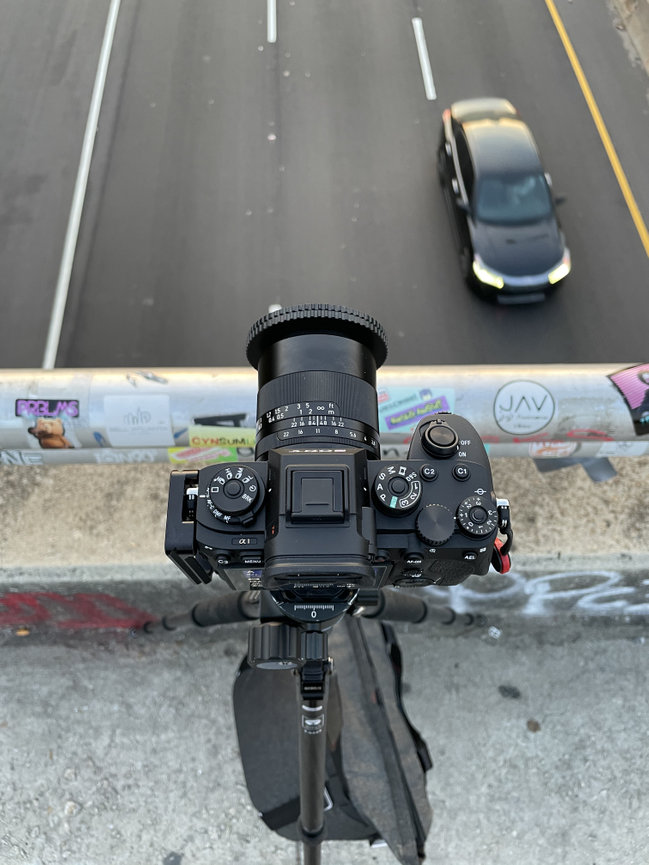- Check the price of the Carl ZEISS Otus 85mm f/1.4 Apo Planar on B&H Photo
At the beginning of 2021 I obtained the new flagship camera from Sony, the Alpha 1. Shortly after I decided to do an assignment for ZEISS, surrounding the Loxia family of lenses. It was thought to be a better pairing if I utilized the flagship lenses of ZEISS, the Otus lenses with the flagship camera of Sony's. I couldn't disagree with that and was glad to finally take out in the field the entire line of Otus lenses. I just finished the reviews for all of the other Otus family of lenses, so be sure to check those out as well! Note: A lot of the verbiage may be similar among these reviews, as they're among the same family and the performance is nearly identical across the board. The difference between them is their focal lengths for the most part.
The Otus 85mm was one of the two Otus lenses I had never photographed with before (the other being the Otus 28mm). I was eager to see how this lens performed in comparison to the other 85mm lenses I own, in the Loxia and Batis family. Just as you'd expect from the Otus it was incredibly clear that not every 85mm lens is created equally. The Loxia and Batis versions are stellar lenses, but the Otus just takes that several steps further. from controlling chromatic aberrations, edge-to-edge image sharpness and stellar wide open aperture performance makes this an unbelievable piece of glass. The Loxia and Batis lenses were already amazing performers in all of those areas, but to see an optic perform even better than those was quite impressive.
My initial use for this lens was mostly on nature, architecture and worship. I know a lens like this 99% of people would utilize this with portraits, which it entirely excels in! A lens of this caliber should be utilized for more than just portraits. You'll find a variety of images here that shows just how good it is in a multitude of areas!
Unlike the majority of the lenses I've reviewed, which are designed for the Sony Alpha E-mount system, the Otus lenses are designed for the Canon EF and Nikon F-mounts. You can utilize these with the Sony mirrorless cameras, via an adapter. If you're planning to do so, then I recommend selecting the Canon EF versions of these lenses and pairing them with the Sigma MC-11 adapter. This will allow for EXIF data to be transferred to the camera, along with electronic operation of the aperture (if you utilize an adapter without electronic controls then you won't be able to adjust the aperture and it will remain wide open at f/1.4).
As this lens is among the flagship of the still camera lenses for ZEISS, this comes with a hefty price tag, of $4,490 USD (at the time of writing this blog). That can be a far reach for many photographers, but if you're a working professional and own flagship cameras from Canon, Nikon or Sony, then this lens should be one you consider. It may be a manual lens but it's a lot easier to use manual than most people may think. Give it a try at least and see how it works for you.

Shot with Sony Alpha 1
ZEISS Otus 85mm Specs
- Canon EF & Nikon F-Mount (Full Frame lens)
- APOCHROMATIC PLANAR Optical Lens Design
- Aperture Range: f/1.4-f/16
- ZEISS T* Anti-Reflective Coating
- 86mm Diameter Filter Thread
- Metal Construction
- 28 degrees - Angle of View
- 0.79m Minimum Focus Distance
- Manual Focus
- 2.51 lbs. (1139g) - Weight
Something to note is that this lens is a Full Frame lens, but it can be utilized on cropped APS-H (Canon) and APS-C (Nikon) cameras, which will give you a 35mm equivalent focal range of 136mm (Canon) and 127.5mm (Nikon).

Shot with Sony Alpha 1
What I think about the Otus 85mm
These are optically the best lenses I've ever used in my entire 22 years. I've utilized almost a couple dozen ZEISS lenses in that time frame, but these lenses are even better than what I considered to be the best of ZEISS, such as Loxia and Batis lenses. They're quite massive in comparison to those families of lenses, but when you take one image you immediately see how they were designed to have a reproduction without any compromises.
What do I mean by no compromises? Otus lenses are designed with one objective. To be the best lens one can produce. This is why these lenses are much larger and heavier than any other ZEISS lens and are all Apochromatic lenses, which have virtually no chromatic aberrations and perform perfectly wide open, without a need to stop down the aperture to increase its performance. You also will notice there's little to no distortion from this lens as well. When I say this lens is VERY good, it's VERY good! It's rather astounding to how amazing the performance of this lens is.
These are manual focusing lenses and just like the other lenses in the ZEISS portfolio, these are incredibly smooth in operation. In having that traditional lens build with the depth of field scale and meter and feet engravings make manual focusing easier than with the auto-focusing lenses, which utilize the focus-by-wire system and doesn’t have accurate manual focusing capability (with the exception of ZEISS Batis lenses).
The Otus 85mm shares the focal length of my ever-popular Batis 85mm lens, but of the four lenses among the family this saw the least amount of usage. Since the 85mm is so common with my work I thought that taking the time to utilize the other focal lengths would be new and different for those looking for other focal lengths and not just the 85mm. The only difference really is the optical performance being stronger than the other ZEISS 85mm offerings.

Shot with Sony Alpha 9
What stands out about the Otus 85mm?
- Apochromatic Lens Design – Otus lenses are all Apochromatic, meaning they have virtually no chromatic aberrations. How true is that? VERY true. You can see in some examples in my full Otus photo gallery of just how there's no CA in the backlit highlight areas of my images (see the below image). At $4,500 this certainly is the kind of performance you'd expect, and this lens doesn't disappoint. You're obtaining the best of the best. This is absolutely a plus for anyone that wants a lens that doesn't require post processing.
- Manual Focus – This is a mechanical lens, where you're gaining the distance markers on this lens and is a must for proper manual usage. This has become a novelty that you don't find on many modern lenses, as they rely on these focus-by-wire systems. For manual usage this kind of system doesn't offer you an accurate experience for manual focusing like these mechanical lenses. You may think that simply owning an autofocusing lens and using it in manual will work just fine, but that's typically not the case. I know there are many who may feel intimidated by manual focusing but trust me it's easier than you think. Just like anything else it takes practice and most importantly, patience!
- Build/Focus Ring - You're obtaining an all-metal design. The lens hood is also a metal construction and has a unique yellow color for the letters and numbers on this lens. It's not anything that's distracting, but it is something rather unique for a lens. The focusing ring of this lens is just like what you're familiar with on many of the other family of lenses, such as Batis and Milvus. The focusing ring is incredibly smooth, with just the right amount of resistance as you turn it.
- Manual Aperture Ring (Nikon version) – This isn’t something unique to the Otus lenses and is something you'll find on the Milvus, Loxia, Classic and ZM ZEISS lenses. If you're someone who prefers having this then you will have it for the Nikon version of this lens. The Canon version is controlled electronically.
- T Coating* - ZEISS lenses are popular for this coating, which reduces lens flare drastically and enhances overall performance of the lens. Whether it’s a filter or lens with this coating you’ll notice the difference from having it vs a lens or filter that doesn’t. It’s always very effective and really brings more contrast to your images. There are times when I do want to have a little bit of lens flare, but the coating of these lenses is so good that it’s sometimes hard to do. The irony!
- Image Quality/Color – Just as with any ZEISS the color and sharpness are great quality, but these lenses are that and much more! It's hard to even describe just how detailed and vibrant the images from this lens are! You will be able to see the quality of these lenses with just about any camera, but high-resolution cameras, like the Nikon D810 or Sony Alpha 1 will take full advantage of this lens and offer the most stunning images you've ever seen! I should warn you that once you try an Otus lens you might not want to ever part with it. Once you see the possibilities of what your images can look like you would find everything else inferior to this. Grant it, the price may be the factor that brings you back to reality, but I'm certain you'll really think long and hard on it, even with the price!

Shot with Sony Alpha 1
What is there to dislike about the Otus 85mm?
- Weather Sealing - At $4,500 one may assume that this lens has everything, but unfortunately this lens does not offer any weather sealing. For some this may be the one factor that deters people from considering this lens. If you're one of those then look at the family of lenses below this, Milvus, which are also designed for the Canon EF and Nikon F mounts, which offers a 1.4/85mm lens as well.
- Size/Weight – As these lenses lack any compromises, which would be taken to produce lenses that are smaller in form and lighter, this lens is a very hefty lens! At slightly over 1100 grams it's a heavy lens. If you're not one to want to carry a lot of weight, then you may be someone that will pass on these lenses. If the quality of this lens outweighs (no pun intended) that then you're going to look past this and only see this lens for the stellar performing optics that it is!

Shot with Sony Alpha 9
What about using the Otus 85mm for video?
You can certainly bet that if these lenses are the best for stills then video will be more of the same. At the end of this blog you'll find a video I produced with the other three lenses in the Otus family, paired with the new Sony Alpha 1 camera. All of the clips in that video were unedited, that way you can really see the true power of these lenses!
Remember, these are larger and heavier lenses and may not be the best option for certain video setups, but they definitely do deliver some incredible visuals.
Is Otus needed if I have other ZEISS lenses?
I've been asked this question quite a lot lately and the real answer is that it depends solely on you and the kind of work you're looking to obtain. I certainly don't expect an amateur or hobbyist to obtain these lenses and really see these being for those who have many of these flagship cameras that are out today, such as the Canon R5, Nikon D810 and Sony Alpha 1 cameras and want to pair their top-of-the-line cameras with lenses that match their quality and capabilities.
If you own any of the other lines, such as Loxia, Milvus or Batis then it's up to you if you just want to add these lenses just to add them, or you're wanting to reserve specific work for these lenses then go right ahead. Optically the other family of lenses are still amazing quality lenses and will do majority of people perfectly fine. As a person who owns almost at least one lens in all of the ZEISS families I can truthfully tell you that you probably won't miss "not" having an Otus lens, but it certainly is nice to have one!
There are numerous 85mm lenses on the market, all of which will be more affordable. It can be a hard lens to justify the Otus if you aren't doing photography as a business. Ideally, I think portrait and commercial photographers may benefit the most from this lens. If you want the best image quality possible, especially if you have clients paying top door for you to photograph then this is what you'd want to show up with. If you're doing more street photography like I do for instance, then this is not going to be the lens for you! The one plus to ZEISS is that they have lenses for everyone, across a wide array of lenses and they're good about keeping all of their lines to the best quality they can possibly produce for that specific family. If you want to have close to Otus quality, but maybe without the price tag of the Otus or as much weight and bulk then look at the Milvus lenses. They offer more focal length options, too!

Shot with Sony Alpha 1
Conclusion: Who is/isn’t this for?
If you have a love for manual focusing lenses and have the money to spend or already own top of the line cameras, then $4,490 USD doesn't matter to you. You may be someone who's commissioned to do a lot of high-profile work and may require the best possible gear. This lens should be something you consider for that.
I certainly don't see anyone who's starting out or not generating income from photography obtaining this lens. It's really the pinnacle of lenses and something many look to being able to afford, whether they have a desire to obtain this lens or not. Don't feel like your imagery won't be great without these lenses. The other family of lenses are great to own as well!
If you own the flagship camera brand of Sony, Canon and Nikon then Otus should be a lens at the top of your list. For high megapixel cameras you certainly want the better glass you can possibly obtain!
More Photos
Click Here to view the full gallery of images taken with the ZEISS Otus 1.4/85mm Apo Planar.
CLICK HERE TO PURCHASE MY LIGHTROOM & PHOTOSHOP (CAMERA RAW) PRESETS

Shot with Sony Alpha 1

Shot with Sony Alpha 1

Shot with Sony Alpha 1

Shot with Sony Alpha 1






Leave a comment
0 Comments